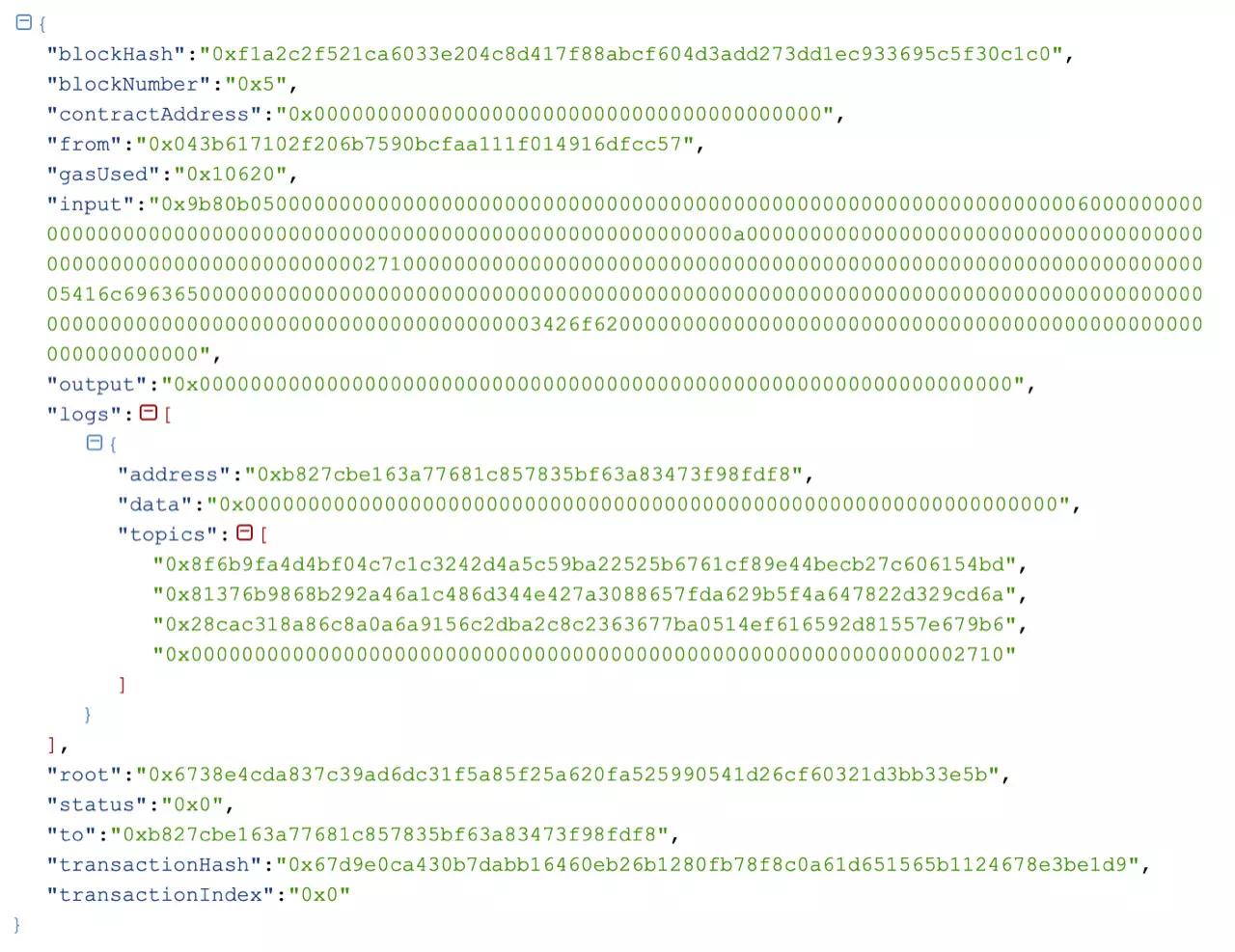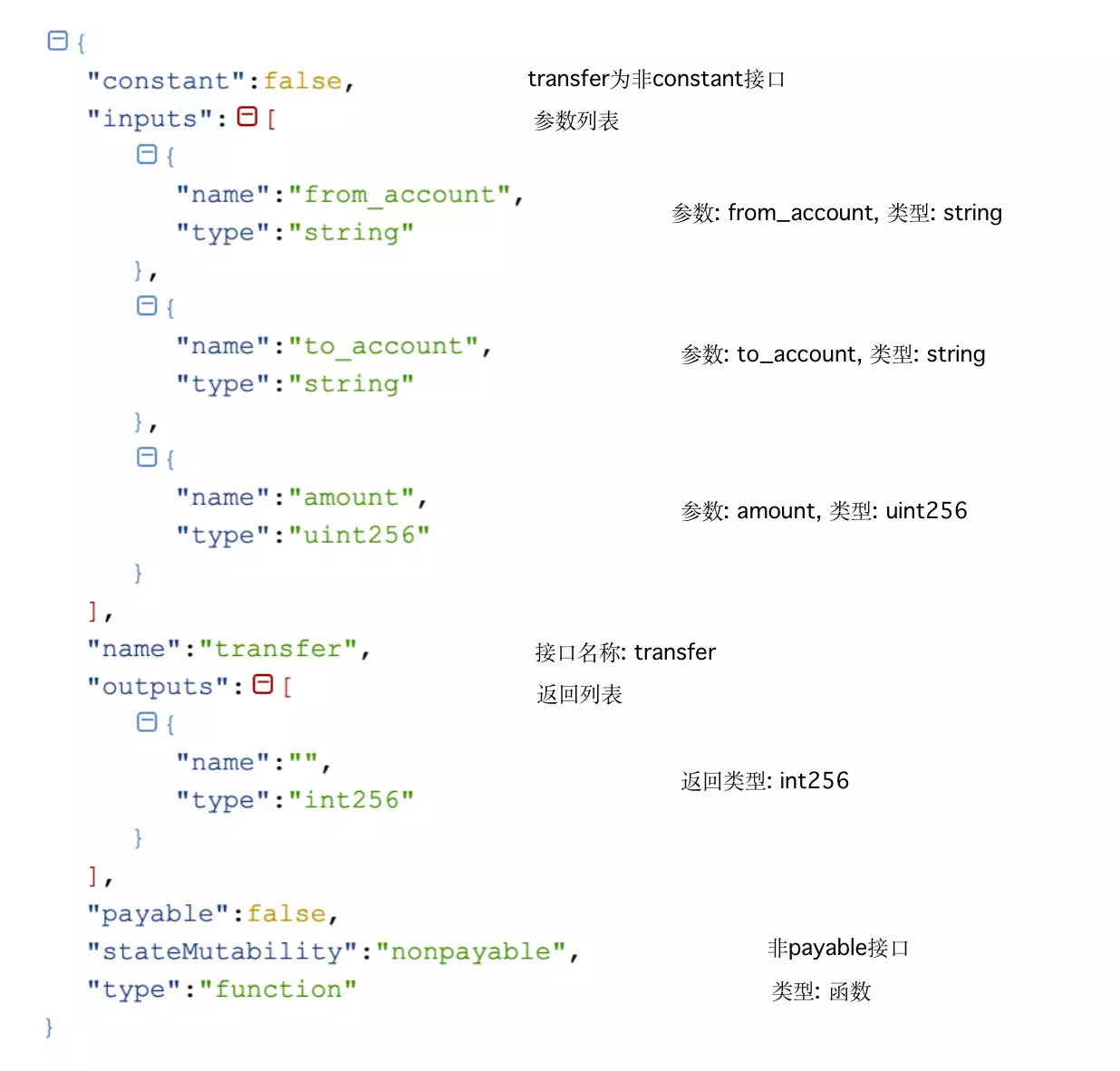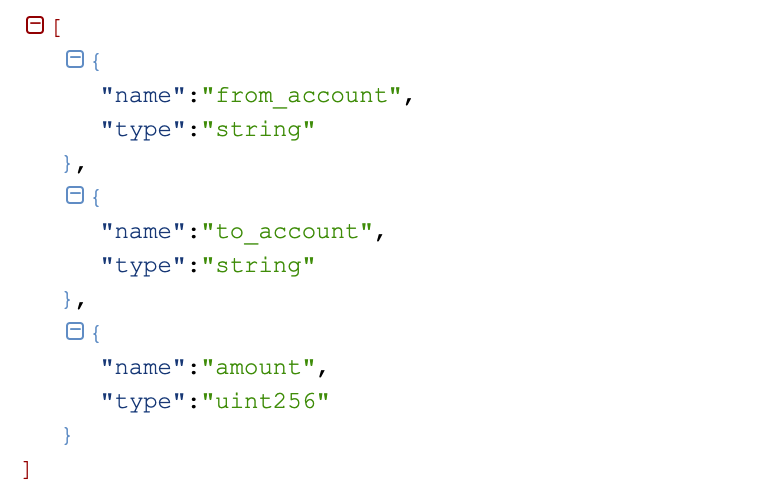发布时间:2020-12-01 来源:本站
作者:王章|FISCO BCOS 核心开发者
引子
当调用合约接口时,可以向区块链发送一笔交易,并获取交易的回执,交易回执保存交易的输入参数、输出、Event log、执行状态等信息。
交易回执示例如下图所示:

交易回执详情如下:https://fisco-bcos-documentation.readthedocs.io/zh_CN/latest/docs/api.html#gettransactionreceipt
在交易回执中,input、output字段可以分别表示交易的输入参数及EVM执行交易后的返回值,这些字段是接口的入参或者返回值根据合约的ABI编码生成的。
什么是合约ABI
“合约ABI是以太坊生态系统中与合约交互的标准方式,不论是外部客户端与合约的交互还是合约与合约之间的交互。”
上述是以太坊官方文档给出的定义,更通俗的理解,包含两方面内容:
ABI是合约接口的说明。
ABI定义与合约进行交互数据编码规则。
下面我们将从这两方面对ABI进行说明。
ABI接口说明
ABI是合约接口的说明,内容包括合约的接口列表、接口名称、参数名称、参数类型、返回类型等。
这些信息以JSON格式保存,可以在solidity文件编译时由合约编译器生成,详情请参考:https://fisco-bcos-documentation.readthedocs.io/zh_CN/latest/docs/manual/console.html#id12
这里以Asset.sol合约为例:

Asset Contract ABI:
[
{
"constant": true,
"inputs": [
{
"name": "account",
"type": "string"
}
],
"name": "select",
"outputs": [
{
"name": "",
"type": "int256"
},
{
"name": "",
"type": "uint256"
}
],
"payable": false,
"stateMutability": "view",
"type": "function"
},
{
"constant": false,
"inputs": [
{
"name": "from_account",
"type": "string"
},
{
"name": "to_account",
"type": "string"
},
{
"name": "amount",
"type": "uint256"
}
],
"name": "transfer",
"outputs": [
{
"name": "",
"type": "int256"
}
],
"payable": false,
"stateMutability": "nonpayable",
"type": "function"
},
{
"constant": false,
"inputs": [
{
"name": "account",
"type": "string"
},
{
"name": "asset_value",
"type": "uint256"
}
],
"name": "register",
"outputs": [
{
"name": "",
"type": "int256"
}
],
"payable": false,
"stateMutability": "nonpayable",
"type": "function"
},
{
"inputs": [
],
"payable": false,
"stateMutability": "nonpayable",
"type": "constructor"
},
{
"anonymous": false,
"inputs": [
{
"indexed": false,
"name": "ret",
"type": "int256"
},
{
"indexed": true,
"name": "account",
"type": "string"
},
{
"indexed": true,
"name": "asset_value",
"type": "uint256"
}
],
"name": "RegisterEvent",
"type": "event"
},
{
"anonymous": false,
"inputs": [
{
"indexed": false,
"name": "ret",
"type": "int256"
},
{
"indexed": true,
"name": "from_account",
"type": "string"
},
{
"indexed": true,
"name": "to_account",
"type": "string"
},
{
"indexed": true,
"name": "amount",
"type": "uint256"
}
],
"name": "TransferEvent",
"type": "event"
}
]
可以看到ABI是一个JSON的对象数组,包含接口与Event的信息。
Asset合约的transfer接口以及其ABI如下:
接口:
function transfer(string from_account, string to_account, uint256 amount) public returns(int256)
接口ABI:

ABI编码
假定用户需要调用Asset合约的transfer接口,已知条件如下。
Asset合约地址:
0x1386bf8e0138e821994140503ee214a9019eb0ec
transfer接口定义:
function transfer(string from_account, string to_account, uint256 amount) public returns(int256);
用户参数:
String fromAccount = "Alice";
String toAccount = "Bob"
BigInteger amount = 10000;
用户如何将这些参数传递给最终执行交易的EVM,使EVM能够知道用户调用的接口为transfer接口,并且EVM能够正确读取用户输入的参数?EVM的返回值用户又该如何使用?
这是ABI的另一个作用,定义了数据的编码格式。
这里以引子中交易回执的input字段为例来分析交易的输入编码:
"input": "0x9b80b050000000000000000000000000000000000000000000000000000000000000006000000000000000000000000000000000000000000000000000000000000000a000000000000000000000000000000000000000000000000000000000000027100000000000000000000000000000000000000000000000000000000000000005416c6963650000000000000000000000000000000000000000000000000000000000000000000000000000000000000000000000000000000000000000000003426f620000000000000000000000000000000000000000000000000000000000"
input数据可以分为函数选择器和参数编码两部分。
1. 函数选择器(Function Selector)
用来指定调用的函数,函数签名Keccak哈希的前四个字节,EVM根据函数选择器来判断用户调用的是合约的哪个接口。
在transfer接口调用中:
bytes4(sha3(“transfer(string,string,uint256)”)) = 0x9b80b050
2. 参数编码
参数的编码(解码同样适用)需要结合ABI描述信息的内容,根据ABI描述信息中接口的类型列表对参数进行编码。
transfer类型列表:

参数列表:
String fromAccount = "Alice";
String toAccount = "Bob"
BigInteger amount = 10000;
编码流程:
enc(string("Alice"),string("Bob"),uint256(10000)) = "000000000000000000000000000000000000000000000000000000000000006000000000000000000000000000000000000000000000000000000000000000a000000000000000000000000000000000000000000000000000000000000027100000000000000000000000000000000000000000000000000000000000000005416c6963650000000000000000000000000000000000000000000000000000000000000000000000000000000000000000000000000000000000000000000003426f620000000000000000000000000000000000000000000000000000000000"
将Function selector与参数编码两部分合并,最终得到input。
合约ABI的优势与局限
为什么需要合约ABI
从ABI的定义就可以看出,ABI是与合约交互的标准形式,相当于定义访问合约接口协议规范,统一了合约与合约、不同平台的客户端与合约之间的交互形式。
合约ABI的局限
下面来谈谈合约ABI编码的一些局限:
ABI编码本身的规则很复杂,这增加了用户实现的难度,不过除了个别ABI库的作者外,普通用户并不需要自己实现。
ABI的编码会对所有的数据编码强制32字节对齐,最终这些编码数据都需要随交易进行持久化,浪费了很多的存储空间。
升级困难:ABI添加新的类型支持甚至是新的规则时,所有平台的实现都需要升级,这些新的特性在有的平台上不一定容易支持。比如:ABIEncoderV2到目前为止,各个库的支持仍然不是很完善。
总结
本文介绍了合约ABI的概念,ABI的JSON描述信息以及ABI编解码,并且最后分析了ABI编解码的优势与局限,让用户对合约ABI有一个初步的了解认识。
大家如果有更深入的需求,可以查看ABI的官方文档:https://solidity.readthedocs.io/en/develop/abi-spec.html
参考资料
Asset.sol源码 : https://github.com/FISCO-BCOS/LargeFiles/raw/master/tools/asset-app.tar.gz